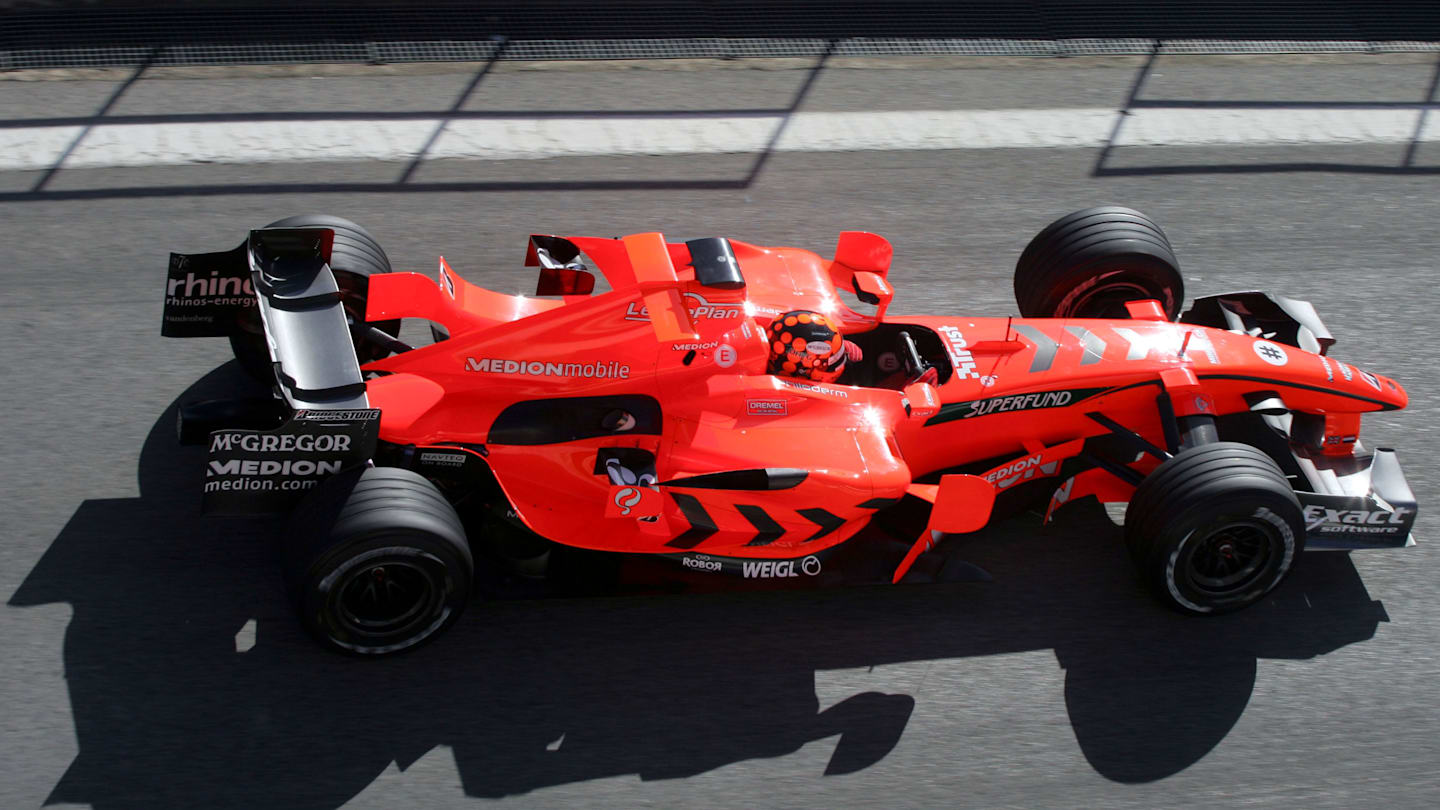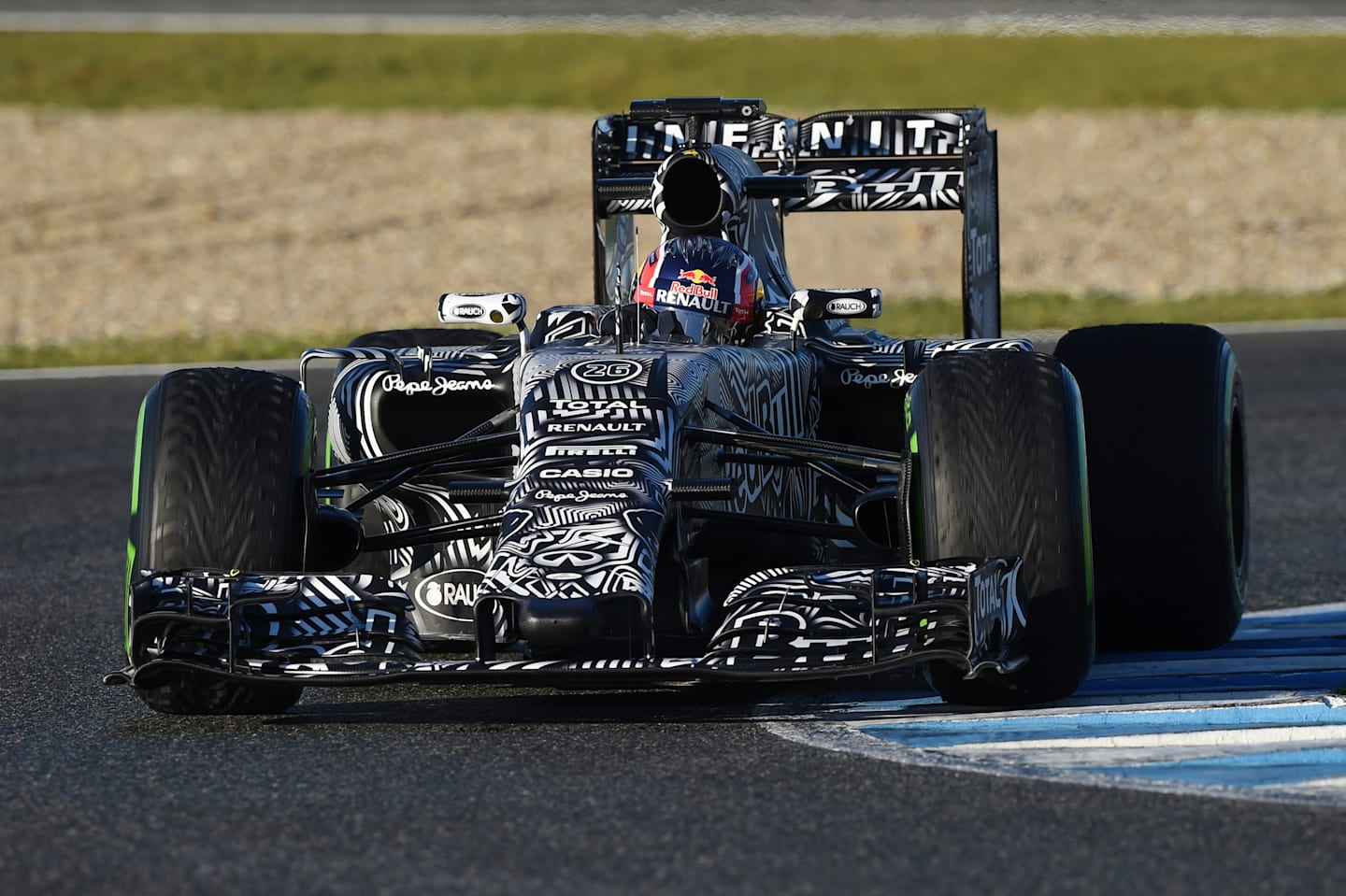As striking as Red Bull’s ‘camouflage’ livery was at Jerez in 2015, it is by no means the first time a team has opted to run a unique colour scheme during winter testing. We look back through the archives at some of the most unusual and memorable liveries to have appeared over recent years...
McLaren go back to their roots, 1997

Mika Hakkinen (FIN) McLaren Mercedes. Formula One Testing, Jerez, Spain, 15-20 January 1997.
Bruce McLaren originally painted his racing cars in white and green, but it’s the bright orange that adorned his eponymous cars in the late Sixties and early Seventies that became synonymous with the team. McLaren have reverted back to the colour twice during testing in recent years, in 1997 (pictured) and again in 2006.
(© Sutton Images)
BAR’s sponsor-free debut, 1999

Jacques Villeneuve (CDN) BAR 001 Mecachrome. Formula One Testing, Barcelona, Spain, 13-15 January 1999.
Driven by Jacques Villeneuve, BAR’s first ever car - the aptly named BAR 01 - appeared in pre-season testing in 1999 with this sponsor-free blue, black and silver livery. However, at the first race in Melbourne the colour scheme had been completely revised.
(© Sutton Images)
Williams’ ‘go faster’ stripes, 1999

FORMULA ONE TESTING. 5/10/99. A1-RING, AUSTRIA. JORG MULLER TEST DRIVES THE BMW POWERED REVISED WILLIAMS FW20. World © COATES/LAT Photographic Tel: +44 (0) 181 251 3000 Fax: +44 (0) 181 251 3001 Somerset House, Somerset Road, Teddington, TW11 8RU
Williams have run interim liveries several times in testing, most recently last season when they used a navy blue car throughout pre-season. But this stripy effort, which was run at Spielberg in 1999 during a test with incoming engine partner BMW, was arguably the best of the lot. For those wondering, ace touring car racer Jorg Muller is the man in the cockpit.
(© LAT Photographic)
Renault’s nod to the past, 2002

Fernando Alonso (ESP) Renault F1 Formula One Testing, Barcelona 7 - 11 January 2002 BEST IMAGE
Renault’s pale blue and yellow colour scheme became one of the most iconic on the grid in the 2000s, thanks largely to the man behind the wheel in this picture - Fernando Alonso. But before that came this rather simple test livery from 2002 which featured just a splash of the famous yellow hue raced by Renault in the late Seventies and early Eighties.
(© Sutton Images)
Red Bull take inspiration from drinks can, 2004

David Coulthard (GBR) Red Bull Racing. Formula One Testing, Jerez, Spain, 8 December 2004. DIGITAL IMAGE
When Red Bull began testing in late 2004, having completed a takeover of Jaguar Racing, they did so with a car livery that took direct inspiration from one of the drinks giants’ iconic cans. However, by the time David Coulthard (pictured) and Christian Klien lined up on the grid in Australia the following year, the team had adopted the predominantly dark blue colour scheme that’s still used today.
(© Sutton Images)
Honda keep it simple, 2007

James Rossiter (GBR) Honda RA107 Formula One Testing, Valencia, Spain. 31 January 2007 DIGITAL IMAGE
Honda weren’t the first team to adopt an all-black livery in testing, but this early 2007 effort makes our list simply for the contrast that was provided by the colourful (and some would say garish) ‘earth livery’ that replaced it. Maybe they should have stuck with the black…
(© Sutton Images)
Spyker’s eye-popping orange number, 2007

Christijan Albers (NED) Spyker F8-VII. Formula One Testing, Barcelona, Spain, Day Two, Tuesday 13 February 2007. DIGITAL IMAGE
Having acquired Midland, new owners Spyker were keen to make a splash in testing, and swiftly adopted a bright orange colour scheme in deference to their Dutch roots. Ultimately the team decided to change to a different shade of the colour after finding that the original hue was so bright that it often appeared red in photos and on TV.
(© Sutton Images)
Force India debut in burgundy, 2008

Adrian Sutil (GER) Force India F1. Formula One Testing, Day Three, Jerez, Spain, Wednesday 16 January 2008
Following Vijay Mallya’s acquisition of Spyker ahead of the 2008 season, Force India tested with this rather smart burgundy, white and gold livery. However, the colour scheme didn’t last long - by the beginning of the season the sidepods were adorned with an orange/red hue.
(© Sutton Images)
Red Bull’s camouflage look, 2015

www.sutton-images.com Daniil Kvyat (RUS) Red Bull Racing RB11 at Formula One Testing, Day Four, Jerez, Spain, 4 February 2015.
In recent years we’ve become accustomed to sportscar manufacturers running with ‘dazzle camouflage’ liveries during early development, but Red Bull are the first F1 team to adopt the same approach. The complex black and white colour scheme, which apes the look used by allied naval ships during the first and second world wars, makes it extremely difficult to see certain details on the car, though you can be sure that Red Bull’s rivals will be doing their best to see through the disguise!
(© Sutton Images)

/EAS_F1_25_ICONIC_ED_3840x2160_StandingPose%20(1))


